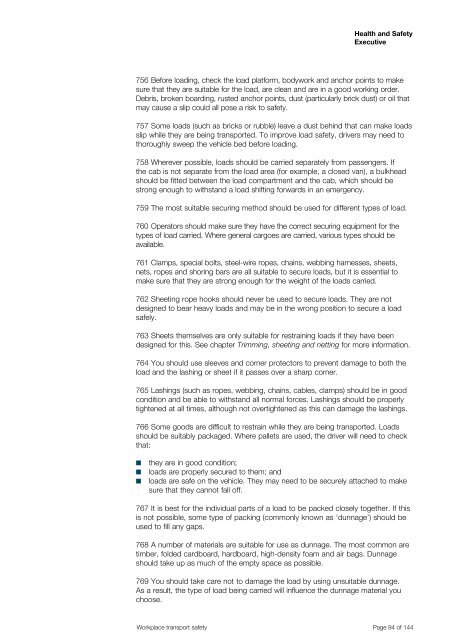Workplace transport safety An employers' guide - ARRI Lighting Rental
Workplace transport safety An employers' guide - ARRI Lighting Rental
Workplace transport safety An employers' guide - ARRI Lighting Rental
Create successful ePaper yourself
Turn your PDF publications into a flip-book with our unique Google optimized e-Paper software.
Health and Safety<br />
Executive<br />
756 Before loading, check the load platform, bodywork and anchor points to make<br />
sure that they are suitable for the load, are clean and are in a good working order.<br />
Debris, broken boarding, rusted anchor points, dust (particularly brick dust) or oil that<br />
may cause a slip could all pose a risk to <strong>safety</strong>.<br />
757 Some loads (such as bricks or rubble) leave a dust behind that can make loads<br />
slip while they are being <strong>transport</strong>ed. To improve load <strong>safety</strong>, drivers may need to<br />
thoroughly sweep the vehicle bed before loading.<br />
758 Wherever possible, loads should be carried separately from passengers. If<br />
the cab is not separate from the load area (for example, a closed van), a bulkhead<br />
should be fitted between the load compartment and the cab, which should be<br />
strong enough to withstand a load shifting forwards in an emergency.<br />
759 The most suitable securing method should be used for different types of load.<br />
760 Operators should make sure they have the correct securing equipment for the<br />
types of load carried. Where general cargoes are carried, various types should be<br />
available.<br />
761 Clamps, special bolts, steel-wire ropes, chains, webbing harnesses, sheets,<br />
nets, ropes and shoring bars are all suitable to secure loads, but it is essential to<br />
make sure that they are strong enough for the weight of the loads carried.<br />
762 Sheeting rope hooks should never be used to secure loads. They are not<br />
designed to bear heavy loads and may be in the wrong position to secure a load<br />
safely.<br />
763 Sheets themselves are only suitable for restraining loads if they have been<br />
designed for this. See chapter Trimming, sheeting and netting for more information.<br />
764 You should use sleeves and corner protectors to prevent damage to both the<br />
load and the lashing or sheet if it passes over a sharp corner.<br />
765 Lashings (such as ropes, webbing, chains, cables, clamps) should be in good<br />
condition and be able to withstand all normal forces. Lashings should be properly<br />
tightened at all times, although not overtightened as this can damage the lashings.<br />
766 Some goods are difficult to restrain while they are being <strong>transport</strong>ed. Loads<br />
should be suitably packaged. Where pallets are used, the driver will need to check<br />
that:<br />
n they are in good condition;<br />
n loads are properly secured to them; and<br />
n loads are safe on the vehicle. They may need to be securely attached to make<br />
sure that they cannot fall off.<br />
767 It is best for the individual parts of a load to be packed closely together. If this<br />
is not possible, some type of packing (commonly known as ‘dunnage’) should be<br />
used to fill any gaps.<br />
768 A number of materials are suitable for use as dunnage. The most common are<br />
timber, folded cardboard, hardboard, high-density foam and air bags. Dunnage<br />
should take up as much of the empty space as possible.<br />
769 You should take care not to damage the load by using unsuitable dunnage.<br />
As a result, the type of load being carried will influence the dunnage material you<br />
choose.<br />
<strong>Workplace</strong> <strong>transport</strong> <strong>safety</strong> Page 94 of 144
















